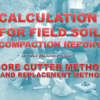In geotechnical engineering and material sciences, a very common concept regarding soil is void ratio. We deal with this concept in hydrogeological properties of soil. If you look at the void-ratio formula you’ll come to know that this dimensionless quantity plays a vital role in different properties of soils.
The voids in soil not only affect the shear strength of soil. But it also impacts the compressive strength and permeability. The shape of the soil particle and the size distribution impacts the void ratio in soil.
Let’s now explore in detail about void ratio formula:
Three Phase system of Soil
Soil mass is a three-phase system consisting of solid particles, water, and air, which is shown in figure below:
Total volume of soil mass constitutes volume of solid particles Va volume of water Vw and volume of air Va. Volume of void Vv is thus sum of volume of air and volume of solid particles. In mathematically form it is written as:
Vv=Va+Vw
Since weight of air is negligible therefore weight of voids will be equal to weight of water. In mathematically form, it is Wv = Ww
Weight of solid is represented by Ws thus total weight of soil is given as. W = Ww + Ws

Technical terms use in soil mechanics
Void Ratio (e):
It is the ratio of total volume of voids Vv to the volume of soil solids Vs in a given soil mass. Mathematically,
e=Vv/Vs
Porosity of Soil Mass (n):
It is the ratio of total volume of voids Vvto the total volume of the given soil mass (V. Mathematically,
n=Vv/V
Difference between porosity and void ratio
-
Can void ratio be more than 1? Porosity is always less than 100%. However, the void ratio may be less than 1 or greater than or equal to 1.
-
Interesting: Which soil type has the largest value of porosity? Clay is the most porous sediment but is the least permeable. Clay usually acts as an aquitard, impeding the flow of water. Gravel and sand are both porous and permeable, making them good aquifer materials.
Degree of Saturation of soil mass (s):
It is the ratio of the volume of water Vw present in a given soil mass to the total volume of the voids Vv in it. Mathematically,
s=Vw/Vv
For fully saturated soil, Vw = Vv and hence s=1.
For perfectly dry soil, Vw = 0 and hence s=1.
Also Read: Expansive soils – Identification – Types
Percentage of air void
It is the ratio of the volume of air voids Va to the total volume of the soil mass (V) and is expressed in percentage. Mathematically,
na = ( Va / V ) x 100
Density Index of Soil Mass
It is the ratio of difference between the void ratio of the soil in loosest state emax and its natural void ratio (e) to the difference between the void ratio in the loosest state emax and the densest state emin Mathematically,
Id = ( emax – e ) / (emax – emin)
Relationship of void ratio (e) with different parameters
- Relationship between void ratio (e) and porosity (n)
So, how do you calculate void ratio when porosity is given: below is the formula
e = n / (1-n)
Note: The void ratio, VV / VS, is always larger than the total porosity, VV / VT, because the value of VS (the denominator of the void ratio) is always less than the total sample volume, VT.
- Relationship between porosity (n) and void ratio (e)
n = e / (1+e)
- Relation between void ratio (e), degree of saturation (s), water content (w) and specific gravity of solids (G):
Water content is the ratio of weight of water to weight of solids and represented by (w). In mathematically form it is, w = Ww / Ws
specific gravity is the ratio of weight of given volume of soil solid at given temperature to the weight of equal volume of distilled water at that temperature. It is represented by G.
This relationship is represented in mathematically form by wxG = s x e
Also Read: Field Density Test (FDT) 7 Methods and their Comparison
Relation between dry unit weight γd, bulk unit weight γ and water content (w).
Dry unit weight is the ratio of weight of soil solids to the total volume of soil mass. It is represented by and in mathematically form given as γd = Ws / V
Bulk unit weight is the ratio of weight of soil to the volume of soil. It is represented by and in mathematically form it is given as γ = W/V.
This relationship is given by γd = γ / (1+w)
- Relation between dry unit weight γd, Specific gravity (G), void ratio (e):
This relationship is given by
γ = (G x γw) / (1+e)
If void ratio (e) is replaced by porosity (n), then above relation will be written as;
γd = G x γw (1-n)
- Relation between saturated unit weight (γ sat), specific gravity (G), and void ratio (e)
Saturated unit weight is the ratio of weight of saturated soil mass to total volume of soil mass. In mathematically form, it is written as γsat = Wsat / V
This relationship is given in mathematically form as,
γsat =( γw / (1+e)) x (G+e)
If void ratio (e) is replaced by porosity (n). Then this relationship will be given as.
γsat = G x γw (1-n) + n. γw
Also Read: Dry density of soil – Relationship of dry density with moisture content
Key takeaways
Theoretically if we say, void ratio tells about how much empty space is there in the soil compared to it’s soil particles and porosity tells us about how much empty space is there in the soil compared to its total content.
There is not much difference but voids ratio can go beyond 1 but porosity cannot. Meaning that there can be more pores in a soil than its solid particles but there cannot be more voids.



















